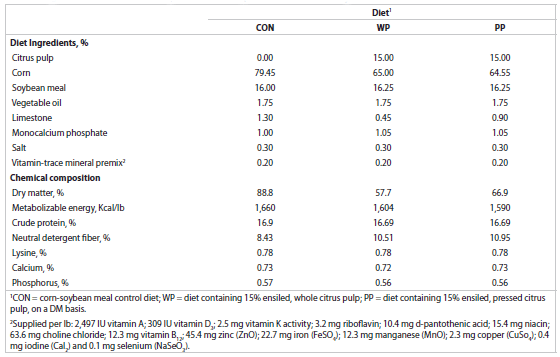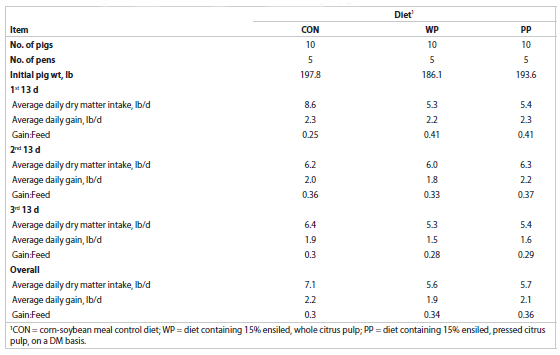



Feeding Ensiled Citrus Pulp to Finishing Pigs
Feeding ensiled whole or pressed citrus pulp to finishing pigs offered some savings, according to J.D. Crosswhite, N.B. Myers, A.T. Adesogan, J.H. Brendemuhl, D.D. Johnson, and C.C. Carr of the Institute of Food and Agricultural Sciences (IFAS) at the University of Florida. However, the corn-soy control diet resulted in a lower cost of gain when the additional labour costs were taken into account.Introduction
Feed costs have historically been the single largest cost of
pork production. For the past six years, feed costs have
continually increased, which has driven all facets of animal
agriculture in the United States to attempt to reduce feed
costs. Florida has greater feed costs than the rest of the
country because grain must be shipped here from where
it was produced. Taking into account transportation costs,
corn in Florida is approximately $1.25 per bushel more
expensive on average than in the Midwest. A pig consumes
approximately 650 lbs. of complete feed from birth until
slaughter, and approximately 70 per cent of the diet is corn. This
means it costs over $10 more to raise a pig in Florida than
the Midwest because of the cost of corn alone.
Increased feed costs combined with decreased slaughter
capacity have dramatically decreased pork production
throughout the southeastern US, except for North
Carolina. Florida currently ranks 36th nationally for pork
production (NPB 2012). The state's swine inventory was
reduced by half from 2001 to 2005 but since then, it has been
consistently estimated at 20,000 animals (FDACS 2011).
The few Florida pork producers active today generally
obtain prices above market value for their pigs because of
the strong demand for locally-raised foods or by selling
pigs to youth for exhibition (Carr, Eubanks and Dijkhuis
2008a).
The number of small USDA-inspected pork
processors in Florida has increased over the past five years
(Carr, Eubanks, and Dijkhuis 2008b). These Florida pork producers could become more profitable if they could
significantly decrease their production costs.
Florida produced approximately three million tons of citrus
pulp in 2011, which was primarily used as a byproduct
feedstuff in ruminant diets (FDACS 2011). Raising
monogastric animals (such as pigs) for food production is
often criticised because these animals consume feedstuffs
that could be used for human consumption. However,
citrus pulp is a byproduct of the citrus juicing industry,
and humans do not generally consume it. In Florida, pork
producers have an opportunity to use citrus byproducts as a
feedstuff to substantially and sustainably decrease their feed
costs.
Feeding Citrus Pulp to Livestock
Three primary types of citrus pulp are used as a byproduct
feedstuff in livestock diets — whole citrus pulp, pressed
pulp and dried pulp.
Whole citrus pulp (pulp residue,
rind, and seed) contains approximately 10 per cent dry matter, immediately after the juice is removed. Whole
citrus pulp (WP) is then pressed to extract citrus liquor,
and 0.05 per cent calcium carbonate is added during grinding to
make pressed pulp, which contains approximately 20 per cent dry matter.
Pressed pulp (PP) is heated to make dried pulp (DP), which
contains approximately 90 per cent dry matter.
DP is sold as a commodity
feedstuff but WP and PP are available at little to no cost
because citrus processors want to avoid further processing
costs for those products. However, animal producers must pay the transportation cost for WP or PP products.
Depending on the length of transportation, these costs can
become cost prohibitive, especially since over 80 per cent of the
load is water. Because these products are high in fructose
and over 80 per cent water, WP and PP products should either be
fed within three days of production or preserved by ensiling
to extend their storage life.
In a recent University of Florida trial, 30 finishing pigs were
fed either a control diet of corn-soybean meal or the same
diet, with 15 per cent replaced by either anaerobically ensiled WP
or PP on a dry-matter basis (Table 1). Compared to the control
diet, diets containing ensiled citrus pulp had additional
soybean meal, monocalcium phosphate, and less limestone,
which allowed all diets to contain 0.78 per cent lysine and the
same calcium:phosphorus ratio. Metabolizable energy
values were similar for the diets at 1,660Kcal per lb (control
diet), 1,604Kcal per lb (WP diet) and 1,590Kcal per lb (PP diet)
(Table 1).
Table 1. Ingredients and chemical composition of the experimental diets on a dry matter basis.

Compared to pigs fed the control diet across the feeding period, pigs fed the PP diet displayed a 20 per cent improvement in feed efficiency (Gain:Feed), while those fed the WP diet had a 13.3 per cent improvement (Table 2). These differences in efficiency primarily occurred during the first two weeks of feeding (Table 2). Although the data are not shown in this report, replacing 15 per cent of the diet dry matter with ensiled citrus pulp had marginal effect on carcass traits, pork shelf life, and pork sensory characteristics.
Table 2. Effect of dietary citrus pulp inclusion on growth and feed efficiency of pigs

Replacing 15 per cent of the diet DM with ensiled citrus pulp can decrease the cost of gain if those feedstuffs are accessible close to the swine operations. But these savings might be negated depending on labor and transportation costs (Table 3).
Table 3. Effect of dietary citrus pulp inclusion on cost of gain per pig ($/lb gained).

In this study, cost per lb of live gain was calculated using
current wholesale prices for all ingredients except the high
moisture citrus byproducts. Transportation costs for the
high moisture citrus byproducts were calculated as follows:
((300 miles round-trip ÷ 10 miles/gal) × $3.50/gal) ÷ 20,000
lbs. of high-moisture citrus byproduct or 10,000 lbs. of both
WP and PP.
This would be the same as considering a $105 delivery fee.
The costs per lb of the diets on a dry-matter basis were calculated
to be $0.18 (control diet), $0.12 (WP diet), and $0.13 (PP
diet). Additionally, an hour of work/high moisture citrus
treatment per day × minimum wage ($7.80) was included
as labor cost. Cost of gain per pig was calculated as follows:
((((total DM intake/pen × diet $/lb DM) + labour $/per pen)
÷ live wt. gain/pen) ÷ # of pigs/pen).
Management is important when feeding an ensiled high
moisture feedstuff to pigs. These feedstuffs should be
used within two to three days after removing from the ensilement
container to prevent spoilage and mycotoxin development
from mold. Additionally, these diets require additional
labor as described earlier to ensile the high-moisture pulp,
to mix and blend feed more frequently to maintain feed
quality and palatability, and to prevent feed bridging,
clumping, and waste within the feeders. Feeding ensiled
citrus pulp probably has even better application for gestating
sows because feed is generally offered once daily on the
floor, minimizing problems with feeders. Also, sows have
improved hindgut fermentation compared to finishing
pigs, suggesting that ensiled citrus pulp could be fed at an
increased rate (Sotto et al. 2009).
References
Carr, C.C., L.E. Eubanks and R. D. Dijkhuis. 2008a. Adding value to livestock with niche meat marketing programs. AN197. Gainesville, FL: University of Florida Institute of
Food and Agricultural Sciences.
Carr, C.C., L.E. Eubanks and R.D. Dijkhuis. 2008b. USDA-inspected livestock slaughter facilities in Florida. Gainesville, FL: University of Florida Institute of Food and
Agricultural Sciences.
FDACS (Florida Department of Agriculture and Consumer
Services). 2011. 2011 Florida agriculture by the numbers. Tallahassee, FL: FDACS.
NPB (National Pork Board). 2012. Quick Facts: The pork industry at a glance. Des Moines, IA: National Pork Board.
Sotto, V.R., M. Brito, B. Lopez, E. Perez and F. Velazquez. 2009. Use of Citrus Meal for Feeding Sows during the
Gestation and Lactation Stage. Revista Computadorizada de Produccion Porcina 16(1):45-49.
September 2012








